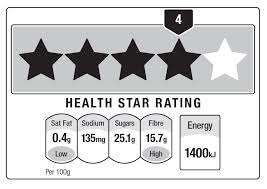
Australia's proposed Health Star Rating System for food labelling
New Zealand’s nutritional food labels are not as effective as once thought and could be impacting on the health of New Zealanders, according to new research from the University of Cantebury in Christchurch.
The research, which was a marketing study that collected a total of 591 online responses, found that consumers react better to labels that provide “relatable, transparent” information that is easily converted in exercise expenditure or clearly states which products are “good” and which are “bad”.
Study method
Participants were given an identical survey, with only the way in which the nutritional information was communicated being different. The items labels including “walking and running” labels, which stated how many minutes exercise were needed to burn off the product.
“We also included a star system which displayed one, two or three stars on the product, depending on how many calories were in it,” said Michelle Bouton, Postgraduate student and researcher on the project. “A traffic light label was divided into five categories of the main nutritional components and coloured red (bad), orange (moderate) or green (good),” she said.
The researchers said their findings showed that the current daily intake system was “so insignificant that only 23 per cent of participants recalled seeing it”.
“This was alarmingly low compared to the recall rate of the running (89 per cent), walking (93 per cent) and traffic light label (70 per cent),” Ms Bouton said.
The study found that those who were presented with the walking label were most likely to make healthier consumption choices, regardless of their level of preventative health behaviour.
“Therefore, consumers who reported to be unhealthier were likely to modify their current negative behaviour and exercise, select a healthier alternative or avoid the unhealthy product entirely when told they would need to briskly walk for one hour and 41 minutes to burn off the product,” Ms Bouton said.
The study also found that the traffic light system was effective in deterring consumers from unhealthy foods, while also encouraging them to consume healthy products. Although the running label was found to be effective with participants who reported a healthy lifestyle, it was found to be ineffective with those who were yet to adopt a healthy lifestyle.
“A consumer who does not actively exercise is less likely to start running than a consumer who is already active,” Ms Bouton said.
Images and colours more effective
Associate Professor Ekant Veer, who supervised the study, said the findings differ from what people initially thought would be an effective communication method.
“Information and numeric figures are ineffective at aiding consumers with low levels of health literacy to make healthy consumption choices,” Professor Veer said. “Images and colours are found to be much more effective and understandable forms of communication,” he said.
“As the overwhelmingly high obesity rates in New Zealand continue to climb, something needs to be done to improve the health of our society,” Professor Veer said. “This information provides valuable insight into understanding consumption behaviours associated to food labels,” he said.
Nutrition labelling debate ongoing globally
What is the most effective way to label nutritional content of foods has been a contentious issue globally in recent years.
Australian Food News reported in June 2013 that Australian and New Zealand Minister responsible for food regulation had approved a new front-of-pack labelling (FoPL) system that uses a ‘health star’ rating, with plans for further examination of how the system would apply to dairy products. But the food industry was hesitant about the new system, saying that “serious flaws” still needed to be resolved if an effective FoPL system was to be implemented.
In August 2013, Australian Food News reported that researchers from Aarhus University in Denmark had found that colour coding and text on food labels increased the healthfulness of product choices when consumers were asked to choose a healthful product, but not when they were asked to choose according to their preferences.
Meanwhile, in the UK, the ‘traffic light’ FoPL system, which was introduced in October 2012, got off to a shaky start in June 2013, at the same time as a US food label use study from the University of Alabama found that food labels that target consumers by gender might be beneficial.





